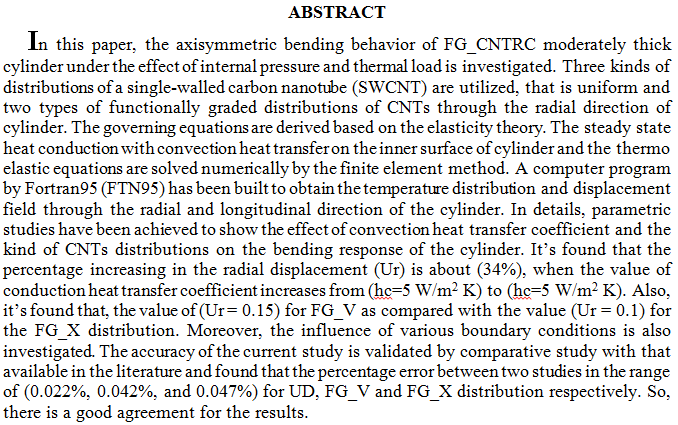
A phytoremediation experiment was carried out with kerosene as a model for total petroleum hydrocarbons. A constructed wetland of barley was exposed to kerosene pollutants at varying concentrations (1, 2, and 3% v/v) in a subsurface flow (SSF) system. After a period of 42 days of exposure, it was found that the average ability to eliminate kerosene ranged from 56.5% to 61.2%, with the highest removal obtained at a kerosene concentration of 1% v/v. The analysis of kerosene at varying initial concentrations allowed the kinetics of kerosene to be fitted with the Grau model, which was closer than that with the zero order, first order, or second order kinetic models. The experimental study showed that the barley plant designed in a subsu
... Show More (12)
(12)
 (10)
(10)
Date palm silver nanoparticles are a green synthesis method used as antibacterial agents. Today,
there is a considerable interest in it because it is safe, nontoxic, low costly and ecofriendly. Biofilm bacteria
existing in marketed local milk is at highly risk on population health and may be life-threatening as most
biofilm-forming bacteria are multidrug resistance. The goal of current study is to eradicate biofilm-forming
bacteria by alternative treatment green synthesis silver nanoparticles. The biofilm formation by bacterial
isolates was detected by Congo red method. The silver nanoparticles were prepared from date palm
(khestawy) fruit extract. The formed nanoparticles were characterized with UV-Vis
 (15)
(15)
 (3)
(3)
 (136)
(136)
 (116)
(116)
The behavior corrosion inhibition of aluminum alloy (Al6061) in acidic (0.1 M HCl) and saline (3.5% NaCl) solutions was investigated in the absence and the presence of expired diclofenac sodium drug (DSD) as a corrosion inhibitor. The influence of temperature and was studied using electrochemical techniques. In addition, scanning electron microscopy (SEM) was used to study the surface morphology. The results showed that DSD acted as a powerful inhibitor in acidic solutions, while a moderate influence was observed with saline one. Maximum inhibition efficiency was 99.99 and 83.32% in acidic and saline solutions at 150 ppm of DSD, respectively. Corrosion current density that obtained using electrochemical technique was increased with temperat
... Show More (40)
(40)
 (36)
(36)
The current study used extracts from the aloe vera (AV) plant and the hibiscus sabdariffa flower to make Ag-ZnO nanoparticles (NPs) and Ag-ZnO nanocomposites (NCs). Ag/ZnO NCs were compared to Ag NPs and ZnO NPs. They exhibited unique properties against bacteria and fungi that aren't present in either of the individual parts. The Ag-ZnO NCs from AV showed the best performance against E. coli, with an inhibition zone of up to 27 mm, compared to the other samples. The maximum absorbance peaks were observed at 431 nm and 410 nm for Ag NPs, at 374 nm and 377 nm for ZnO NPs and at 384 nm and 391 nm for Ag-ZnO NCs using AV leaf extract and hibiscus sabdariffa flower extract, respectively. Using field emission-scanning electron microscopes (FE-
... Show More (1)
(1)
In this study, the antimicrobial properties of newly synthesized Schiff bases (4a-4e) and thiazolidinone compounds (5a-5e) generated from 3,5-dinitrobenzoic acid were assessed. These compounds were obtained by reacting 3,5-dinitrobenzoic acid (1) with ethanol in a few drops of concentrated H2SO4 to produce the ester (2). The acid hydrazide (3), which was produced by treating the ester with hydrazine hydrate, reacted with the proper aldehydes, including 4-bromobenzaldehyde, 4-chlorobenzaldehyde, 4-hydroxybenzaldehyde, 4-methoxybenzaldehyde, and 4-hydroxy-3-methoxybenzaldehyde, respectively, to form Schiff bases (4a-4e). The thiazolidinone compounds (5a-5e) were produced by the cyclocondensation reaction of compounds (4a-4e) with thio
... Show MoreIn this study, the antimicrobial properties of newly synthesized Schiff bases (4a-4e) and thiazolidinone compounds (5a-5e) generated from 3,5-dinitrobenzoic acid were assessed. These compounds were obtained by reacting 3,5-dinitrobenzoic acid (1) with ethanol in a few drops of concentrated H2SO4 to produce the ester (2). The acid hydrazide (3), which was produced by treating the ester with hydrazine hydrate, reacted with the proper aldehydes, including 4-bromobenzaldehyde, 4-chlorobenzaldehyde, 4-hydroxybenzaldehyde, 4-methoxybenzaldehyde, and 4-hydroxy-3-methoxybenzaldehyde, respectively, to form Schiff bases (4a-4e). The thiazolidinone compounds (5a-5e) were produced by the cyclocondensation reaction of compounds (4a-4e) with thio
... Show MoreWriting in English is one of the essential factors for successful EFL learning .Iraqi students at the preparatory schools encounter problems when using their background knowledge in handling subskills of writing(Burhan,2013:164).Therefore, this study aims to investigate the 4thyear preparatory school students’ problems in English composition writing, and find solutions to these pro
... Show MoreThe road network serves as a hub for opportunities in production and consumption, resource extraction, and social cohabitation. In turn, this promotes a higher standard of living and the expansion of cities. This research explores the road network's spatial connectedness and its effects on travel and urban form in the Al-Kadhimiya and Al-Adhamiya municipalities. Satellite images and paper maps have been employed to extract information on the existing road network, including their kinds, conditions, density, and lengths. The spatial structure of the road network was then generated using the ArcGIS software environment. The road pattern connectivity was evaluated using graph theory indices. The study demands the abstractio
... Show More (2)
(2)
